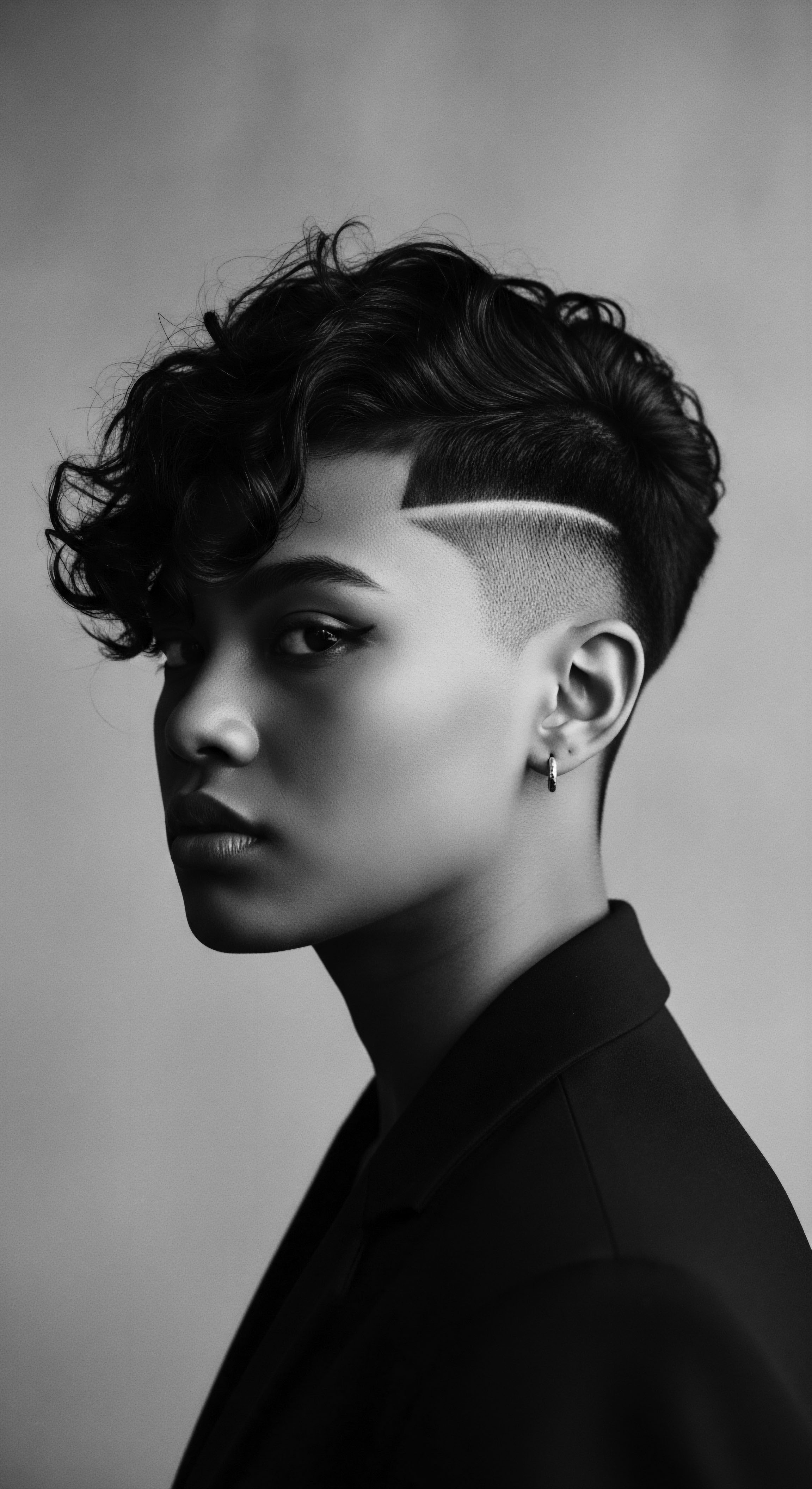
Roots
Consider the journey of a single strand, a coiled helix standing in defiant beauty against the sun’s persistent gaze. For generations, the stories held within textured hair have been more than aesthetic accounts; they speak of survival, of wisdom passed down through ancestral lines, and of a profound connection to the very origins of humanity. This exploration invites us to delve into the elemental biology that equips textured hair with an innate shield against the sun’s powerful rays, understanding its protective mechanisms as a gift from time immemorial. We honor the resilience woven into each curl, recognizing it not only as a marvel of nature, but also a living archive of heritage.

Hair Anatomy and Physiology Unique to Textured Hair
The architectural blueprint of textured hair is distinct, a testament to evolutionary adaptation. Unlike straight or wavy strands, hair with tighter curl patterns emerges from an elliptically shaped follicle, resulting in a strand that possesses a flatter, ribbon-like cross-section. This unique geometry means that the cuticle layers, the outer scales protecting the hair’s inner cortex, do not lie as uniformly flat. The points where the hair bends and twists become areas of increased vulnerability, yet these very kinks contribute to its remarkable thermal regulatory and protective capacities.
Within the cortex of each strand resides Melanin, the natural pigment that gives hair its color. Melanin comes in two primary forms ❉ Eumelanin, responsible for brown and black hues, and Pheomelanin, which imparts red and yellow tones. The ratio and concentration of these melanins dictate the specific shade of hair.
Eumelanin holds a superior protective capacity against ultraviolet radiation, absorbing UV energy and transforming it into harmless heat. This process prevents detrimental light energy from penetrating deeply into the hair shaft, safeguarding its structural integrity and the scalp beneath.

The Melanin Shield in Textured Hair
The presence of higher concentrations of eumelanin in darker, textured hair forms a robust physiological shield. This pigment acts on multiple fronts to mitigate UV damage. First, it functions as a physical barrier, scattering UV radiation and reducing its penetration. Secondly, melanin absorbs UV radiation across a spectrum of wavelengths, dissipating this energy as heat.
This dual action is crucial for preventing damage to cellular DNA and minimizing the formation of free radicals, unstable molecules that can compromise hair proteins, especially keratin. The concentration and distribution of melanin within the hair shaft are key factors in its photoprotective ability.
The deep pigments within textured hair represent an ancient, biological shield, a silent guardian against the sun’s embrace.

How Does Melanin in Textured Hair Biologically Guard Against UV Damage?
Melanin’s protective action in textured hair stems from its unique biophysical properties. Eumelanin, in particular, excels at absorbing both UVA and UVB radiation. UVB radiation is known to cause hair protein loss, while UVA radiation leads to color changes. By absorbing these rays, melanin prevents their harmful effects on the hair’s amino acids and proteins.
It also possesses antioxidant qualities, neutralizing free radicals that UV exposure generates, thereby reducing oxidative stress on hair fibers. This protective mechanism is deeply ingrained, a legacy of human adaptation to environments with intense solar radiation.
The very structure of textured hair amplifies this protection. Its dense, coiled appearance and spiraled structure create a natural barrier. This arrangement allows air to circulate near the scalp, aiding in thermoregulation while also providing an additional physical layer of defense against direct solar exposure.
This evolutionary trait suggests that tightly curled hair, alongside melanated skin, offered early human ancestors a significant survival advantage in high-UV environments. (Lasisi, 2022)
Lasisi, Y. (2022). How Hair Evolved. Sapiens.org.

Historical Evolution of Hair for Solar Defense
Evolutionary biologists propose that Afro-textured hair first developed in Africa among early hominids, serving as an adaptation to the intense ultraviolet radiation of the sun. This perspective suggests that textured hair was perhaps the initial hair type among modern humans, a natural design for life under a powerful sun. The relatively sparse density of such hair, coupled with its elastic helix shape, creates an airy effect, which increased the circulation of cool air on the scalp, an aspect of thermoregulation. This natural architecture, combined with the melanin content, provided significant protection for the scalp and brain from solar radiation, especially as humans began to walk upright.
The story of textured hair is thus intertwined with the story of human migration and survival. It is a biological testament to resilience, a physical manifestation of ancient ingenuity in the face of environmental pressures. Our hair, far from being merely decorative, stands as a functional, protective crown, a heritage written into our very biology.

Ritual
The knowledge of textured hair’s inherent strengths, particularly its defense against solar harm, has echoed through generations, shaping practices and communal wisdom. This segment examines how understanding melanin’s role influenced traditional and contemporary styling choices, tools, and transformations within textured hair communities. These are not merely fashion trends; they are expressions of a living heritage, a continuum of care deeply connected to sustaining the hair’s vitality and honoring its natural protective qualities.

Protective Styling Encyclopedia
Ancestral communities across Africa understood the language of their hair, recognizing its vulnerability to environmental stressors despite its innate protection. This understanding gave rise to a rich lexicon of Protective Styles. These styles, often intricate and time-consuming, served multiple purposes.
They minimized exposure of the hair shaft to direct sunlight, reduced mechanical manipulation, and preserved moisture. Braids, twists, cornrows, and various forms of coiling or wrapping hair close to the scalp were not simply aesthetic choices; they were strategic defenses.
In many cultures, these styling practices held communal and spiritual weight. Hair was often seen as a conduit to spiritual realms or a symbol of identity, age, marital status, or tribal affiliation. For example, the detailed braiding patterns of West African communities served both to protect the hair from the harsh elements and to convey social messages without words. These styles effectively shielded the hair and scalp, reducing the direct impact of UV radiation and preventing dryness that could compromise the hair’s structure.
- Cornrows ❉ Intricate braids lying flat against the scalp, minimizing surface area exposed to sun and reducing tangling.
- Braids ❉ Singular or multiple plaited strands, protecting the length of the hair from environmental wear and tear.
- Headwraps ❉ Often made from natural fibers, these coverings added an additional layer of defense against the sun, particularly crucial for those working outdoors.

Traditional Methods to Enhance Natural Protection
Beyond structural styling, historical practices involved topical applications that complemented melanin’s natural defense. Ancient Egyptians, for instance, used various natural oils to maintain hair health in the scorching desert climate. Moringa oil, castor oil, and almond oil were prized for their hydrating and strengthening properties, which would certainly contribute to the overall resilience of the hair shaft, making it less susceptible to UV-induced damage. While not direct sunscreens, healthy, well-moisturized hair is better equipped to withstand environmental challenges.
The use of wigs in ancient Egypt also offers insight into deliberate scalp protection. Many Egyptians shaved their heads for hygiene reasons in the intense heat, and wigs provided comfort, elegance, and protection from the sun for the exposed scalp. These meticulously crafted hairpieces, often made from human hair or plant fibers, functioned as a practical barrier against solar radiation.
Styling practices rooted in heritage were not just decorative; they were deliberate acts of preservation, enhancing the hair’s natural defenses against the sun.
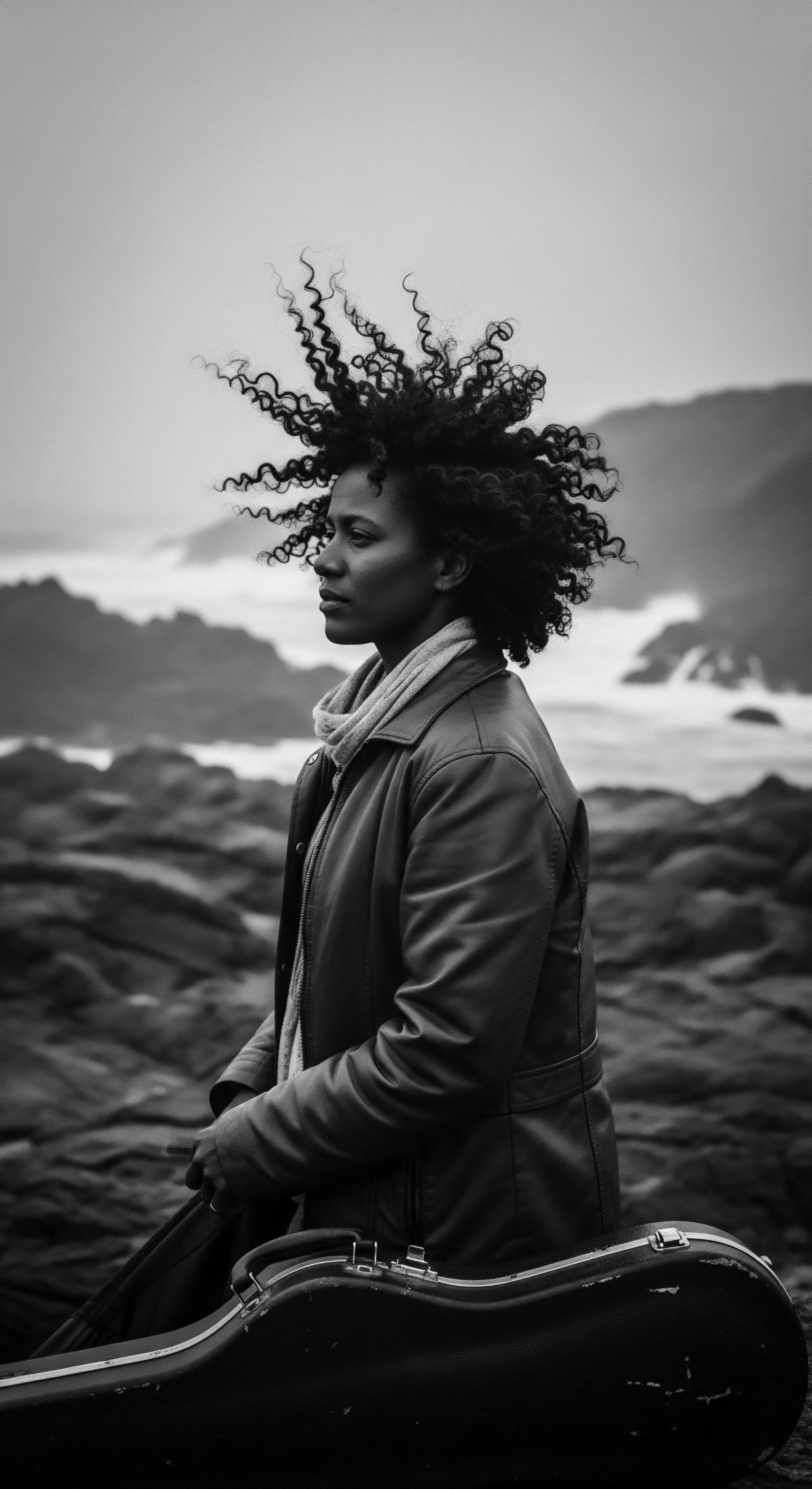
How Does Textured Hair’s Structure Inform Ancestral Styling Choices?
The very nature of textured hair, with its unique coiling patterns, means that natural scalp oils do not distribute as easily down the hair shaft as they would on straight hair. This characteristic can lead to natural dryness, which makes the hair more susceptible to damage from environmental factors. Ancestral practices intuitively countered this. By coiling, twisting, and braiding hair, these communities effectively created a localized microclimate around the strands, helping to trap moisture and facilitate the distribution of natural oils or applied emollients.
This inherent dryness, while a vulnerability, also underlines the critical role of protective styles. Such styles minimized the need for daily manipulation, reducing breakage and allowing natural oils, however slowly they traveled, to coat the strands. The historical emphasis on communal grooming further suggests a shared understanding of how to collectively safeguard hair, translating biological characteristics into collective care strategies.
| Ancestral Practice Intricate Braiding & Coiling |
| Biological/Cultural Connection to UV Protection Reduced direct scalp exposure; created dense canopy that scattered UV rays; minimized mechanical stress, preserving hair integrity. |
| Ancestral Practice Use of Natural Oils & Butters |
| Biological/Cultural Connection to UV Protection Hydrated and sealed the cuticle, supporting the hair's natural barrier against environmental stressors, including sun-induced dryness. |
| Ancestral Practice Head Coverings (Wraps, Tignons) |
| Biological/Cultural Connection to UV Protection Provided an additional physical barrier for both scalp and hair, directly blocking UV radiation. |
| Ancestral Practice These heritage methods reveal a deep, practical understanding of hair's needs, predating modern scientific definitions of UV defense. |

The Role of Wigs and Head Coverings in Historical Protection
The use of wigs and head coverings holds a significant place in the history of hair protection, particularly in hot climates. In ancient Egypt, where sun exposure was relentless, wigs were not simply fashion statements; they were essential for protecting shaved scalps from the intense solar radiation. Crafted from various materials, these headpieces offered a layer of defense against direct sunlight. Similarly, the widespread use of scarves and kerchiefs by enslaved individuals in the Americas served a dual purpose.
They protected against the sun during long hours of outdoor labor and also provided a means to cover hair suffering from malnourishment and scalp ailments, which were unfortunately common due to harsh living conditions. Even when forced by oppressive laws, such as the Tignon Law in 18th-century Louisiana, Black women transformed these mandated head coverings into elaborate, empowering fashion statements, reclaiming autonomy and dignity while maintaining a practical shield against the elements. These historical examples reinforce the enduring connection between protection, practicality, and identity in textured hair heritage.
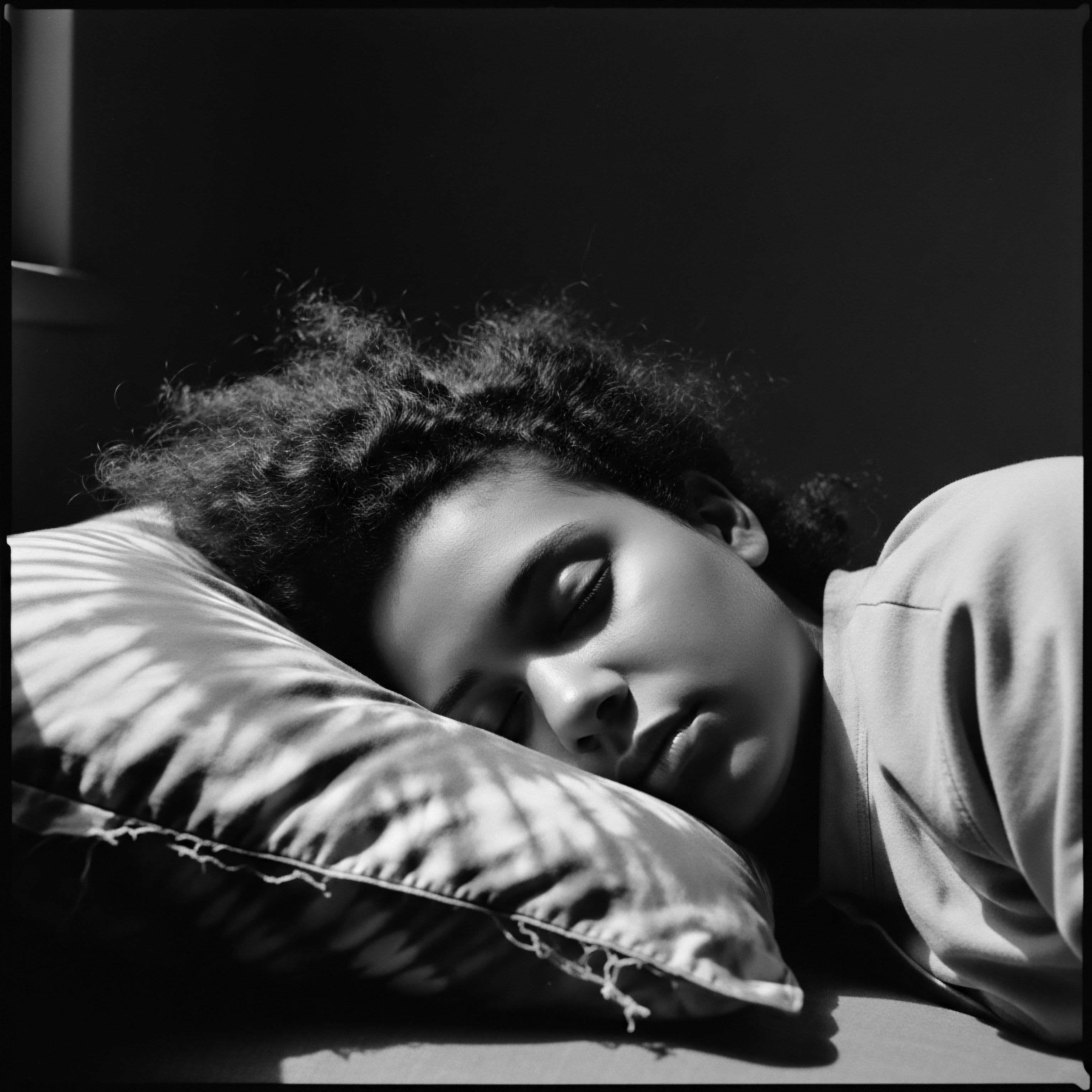
Relay
The biological safeguards within textured hair, coupled with the ancestral practices of its care, lay the groundwork for a holistic understanding of its vitality. This understanding carries forward, shaping contemporary regimens and problem-solving approaches, always reflecting a profound appreciation for the hair’s enduring heritage. The interplay of science, culture, and personal wellness forms a living legacy for textured hair.

Building Personalized Textured Hair Regimens
Contemporary hair care for textured strands often draws inspiration from the enduring wisdom of ancestral practices while integrating modern scientific advancements. The foundation of any effective regimen for melanin-rich hair acknowledges its inherent qualities. The spiral structure, while providing UV and thermal benefits, also makes it more prone to dryness because natural sebum struggles to traverse the entire length of the strand. This characteristic necessitates a regimen centered on moisture retention, gentle handling, and strategic protection.
Modern regimens for textured hair are built upon pillars that align with ancient knowledge ❉ regular cleansing that respects the scalp’s delicate balance, deep conditioning to fortify the hair’s protein structure, and diligent moisturizing to maintain pliability. The choice of products often gravitates towards natural ingredients—shea butter, castor oil, coconut oil—which were staples in historical African hair care and continue to offer tangible benefits, acting as emollients that supplement the hair’s natural defenses against environmental stressors.

The Nighttime Sanctuary ❉ Essential Sleep Protection and Bonnet Wisdom
The wisdom of protecting hair during sleep, a practice deeply ingrained in many Black and mixed-race communities, holds profound significance for preserving the hair’s integrity against mechanical stress and environmental elements. The seemingly simple act of wrapping hair or donning a Satin Bonnet is a direct descendant of ancestral care rituals, preserving precious moisture that might otherwise be lost to absorbent pillowcases. This practice helps to maintain the cuticle layer, crucial for reflecting light and offering a physical barrier against external aggressors, including incidental UV exposure from ambient light.
The bonnet, in its various forms throughout history, served as a nighttime shield, ensuring that the labor of daytime styling and moisturizing was not undone by friction and moisture evaporation. This continuity of care, from styling for sun protection during the day to safeguarding at night, speaks to a comprehensive, inherited understanding of hair’s delicate balance.
- Satin and Silk Bonnets ❉ Minimize friction and prevent moisture loss, preserving natural oils and product applications.
- Hair Wraps ❉ Traditionally used to secure styles and protect hair, adapting to modern materials for nighttime use.
- Protective Hairstyles for Sleep ❉ Braids or twists kept overnight further reduce tangling and mechanical strain, supporting overall strand health.

How Does Understanding Melanin Connect to Modern Hair Care?
Understanding the biological role of melanin in UV defense guides modern hair care towards a holistic perspective. While melanin provides inherent protection, it is not an absolute shield against all forms of UV damage or prolonged exposure. Scientific studies confirm that even melanin-rich hair can experience protein loss and color changes from UV radiation, particularly from UVB. This knowledge reinforces the need for layered protection, combining the hair’s natural advantages with thoughtful care.
Contemporary science, for example, validates the historical use of botanical oils. Many plant-derived oils contain antioxidants that can neutralize free radicals caused by UV exposure, augmenting melanin’s work. This scientific lens allows us to appreciate ancestral practices not merely as traditions, but as informed choices that inadvertently—or perhaps instinctively—supported the hair’s natural protective mechanisms.
| Aspect of Hair Health UV Resilience |
| Heritage Practice Link Intricate braiding, head coverings. |
| Melanin/Scientific Connection Melanin absorbs and scatters UV rays; tight curl structures provide lofted protection. |
| Aspect of Hair Health Moisture Retention |
| Heritage Practice Link Regular oiling with natural butters like shea, nighttime wraps. |
| Melanin/Scientific Connection Melanin functions best in a healthy hair matrix; well-moisturized hair is less prone to UV-induced protein degradation. |
| Aspect of Hair Health Protein Integrity |
| Heritage Practice Link Minimal manipulation, gentle detangling, conditioning masks. |
| Melanin/Scientific Connection Melanin reduces free radical damage to keratin; physical protection prevents protein loss from UV exposure. |
| Aspect of Hair Health The enduring wisdom of heritage practices aligns with modern scientific understanding, revealing how traditional care supported the inherent protective qualities of textured hair. |
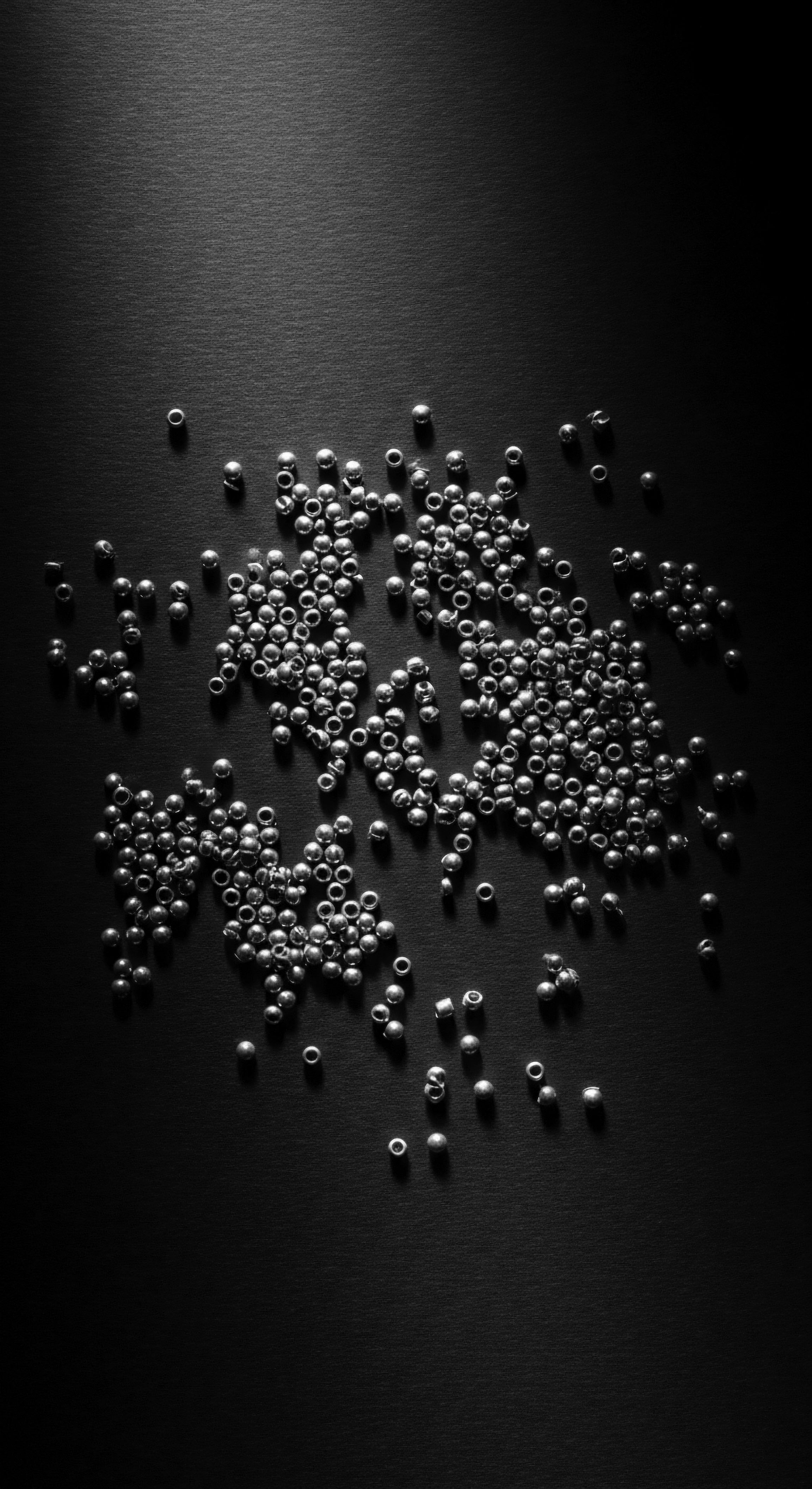
Holistic Influences on Hair Health from an Ancestral Lens
The holistic wellness philosophies inherited from ancestral traditions offer a broader perspective on hair health, seeing it as a reflection of the body’s overall vitality. This view aligns with modern understanding that diet, hydration, stress levels, and even emotional well-being influence hair growth cycles and structural integrity. For generations, communities understood that beauty emanated from within. This meant nourishing the body with nutrient-rich foods, engaging in communal activities that reduced stress, and using natural remedies for internal balance, all of which would contribute to robust hair.
For example, traditional diets rich in plant-based ingredients would naturally supply vitamins and minerals essential for keratin synthesis, the primary protein component of hair. A strong, healthy hair fiber, supported by optimal internal conditions, is better positioned to defend itself against environmental challenges, including the oxidative stress caused by UV radiation. This ancestral wisdom, where hair care was inseparable from self-care and community well-being, continues to guide those who seek a deeper, more resonant path to hair health today.
Modern hair care, when rooted in ancestral wisdom, respects the hair’s biological gifts, augmenting them with practices that echo ancient principles of vitality and protection.

Reflection
The story of melanin in textured hair, as a guardian against the sun’s reach, is a profound narrative stretching back to the earliest human footsteps. This is a legacy inscribed not in scrolls, but within each spiraled strand, a testament to resilience and adaptation. We have charted its course from the fundamental cellular defenses, acknowledging its place in our very genetic makeup, to the ingenious styling rituals passed through countless hands, each knot and twist a quiet defiance, a loving shield.
The exploration of this biological safeguard invites us to look upon textured hair with a renewed sense of wonder and gratitude. It is a living archive, holding the whispers of our ancestors who navigated sun-drenched landscapes, their hair evolving as a crown of protection. This journey, from elemental biology to deeply ingrained practices, reminds us that the care of textured hair extends beyond superficial concerns.
It speaks to a heritage of strength, ingenuity, and unbroken spirit. As we continue to learn, connecting the wisdom of the past with the insights of the present, we affirm the inherent beauty and enduring power of every unique strand, a luminous part of who we are.
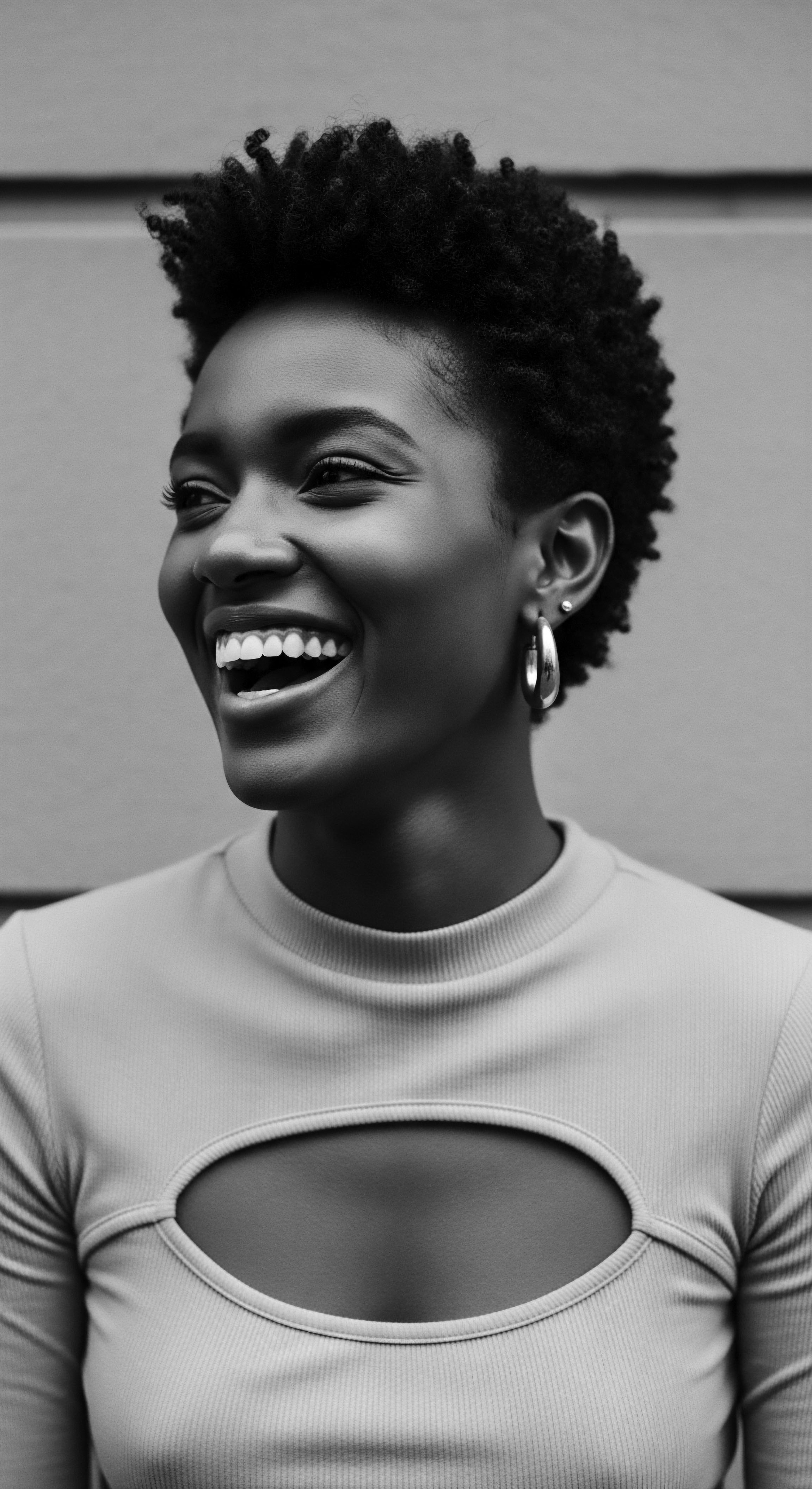
References
- D’Mello, S. Finlay, J. Baguley, B. J. &wik, V. (2016). Signaling Pathways in Melanogenesis. International Journal of Molecular Sciences, 17(12), 1708.
- Gloster, H. M. & Neal, K. (2006). Skin Cancer in Skin of Color. Journal of the American Academy of Dermatology, 55(5), 741-762.
- Jablonski, N. G. (2014). Living Color ❉ The Biological and Cultural Costs of Skin Coloration. University of California Press.
- Lasisi, Y. (2022). How Hair Evolved. Sapiens.org.
- Robbins, C. (2012). The Science of Black Hair ❉ A Comprehensive Guide to Textured Hair Care. CreateSpace Independent Publishing Platform.
- Tosti, A. & Miteva, M. (2018). Hair and Scalp Diseases ❉ Medical, Surgical, and Aesthetic Treatments. CRC Press.
- Tobin, D. J. (2006). Biochemistry of Human Hair ❉ The Structural and Mechanical Properties of Hair. Dermatologic Clinics, 24(1), 1-13.
